Cite this document
(“Management Decision Support System (DSS) Essay Example | Topics and Well Written Essays - 4250 words”, n.d.)
Management Decision Support System (DSS) Essay Example | Topics and Well Written Essays - 4250 words. Retrieved from https://studentshare.org/miscellaneous/1596373-management-decision-support-system-dss
Management Decision Support System (DSS) Essay Example | Topics and Well Written Essays - 4250 words. Retrieved from https://studentshare.org/miscellaneous/1596373-management-decision-support-system-dss
(Management Decision Support System (DSS) Essay Example | Topics and Well Written Essays - 4250 Words)
Management Decision Support System (DSS) Essay Example | Topics and Well Written Essays - 4250 Words. https://studentshare.org/miscellaneous/1596373-management-decision-support-system-dss.
Management Decision Support System (DSS) Essay Example | Topics and Well Written Essays - 4250 Words. https://studentshare.org/miscellaneous/1596373-management-decision-support-system-dss.
“Management Decision Support System (DSS) Essay Example | Topics and Well Written Essays - 4250 Words”, n.d. https://studentshare.org/miscellaneous/1596373-management-decision-support-system-dss.


